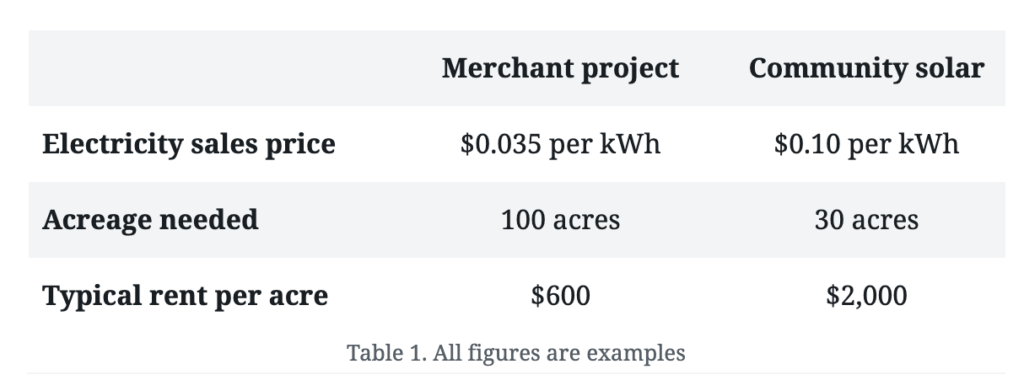If you’re a landowner or farmer, you may have recently received a mailer from a solar energy company offering to build a solar farm on your property. You might be wondering if the offer is real, and if so, how much money you might be able to make.
In this installment of our two-part blog series, we’ll review a few things you should understand as you consider devoting some of your land to solar energy generation.
Why is interest in solar energy growing? In a recent survey, Pew Research found that 70 percent of Americans think generating electricity from solar panel farms is better for the environment than most other energy sources.[1]
What are solar developers hoping to build?
In general, developers are looking to build one of two types of solar farm projects. They’re interested in developing either merchant projects or community solar projects.
Merchant projects are utility-scale solar farms that tie directly into the regional distribution and transmission system. Think of power plants. This level of power generation isn’t necessarily meant for local use. The power goes straight into a regional grid—part of the nation’s large distribution and transmission system—providing energy to anyone within that grid. If your merchant project is located in Pennsylvania, your consumer could live in Virginia.
Community solar developments are much smaller projects designed to serve local consumers.
How do solar developers select potential sites?
Many solar developers start by reviewing county tax and property records looking for sites that are ideal for a solar farm. They overlay the parcel information with utility information, searching for large tracts of land situated in zoning districts that the developers hope will support solar. For a merchant project, these tracts tend to be at least 120 acres.
Developers will eliminate tracts from consideration that are environmentally sensitive, like a conservation area or a state forest. Attractive plots of land include farmland or woodland that can be clear-cut for development; although, woodlands are less favored due to increased development costs.
Next, developers will check to see the proximity of the tract to utility infrastructure like transmission lines and substations. The farther the land is from a tie-in point to transmission lines, the less valuable the property becomes because the developer will have to build facilities to that tie-in and may need to obtain easements and rights of way from other landowners.
How much can landowners make?
To calculate what landowners might earn, it’s important to first distinguish between merchant solar and community solar projects, the economics of which are very different.
Merchant solar projects are much larger than community solar projects. They are at least 100 acres in size. Because these projects are equivalent to power plants, the electricity they generate is supplied directly to the grid and priced at wholesale rates.
Community solar projects are much smaller, maybe 30 or 40 acres at most. But the electricity they generate is priced at retail rates, which could be three times higher than the wholesale rate earned by a merchant solar project.
Because they can sell a kilo-watt hour (kWh) of community solar energy for retail prices, solar developers might pay over three times more to lease land for a community solar project than what they might pay to lease land for a merchant project.

Based on figures from the USDA, solar developers commonly offer farmers a multiple of what they can generate from farming their land with a crop. For example, if a farmer nets $200 an acre per year farming soy, a developer might offer $500 per acre. If the proposed site is 120 acres, the farmer could earn $60,000 annually with a price escalator of between one and two percent year over year. Over the 25-year term, the farmer might earn over $1.5 million.
Conclusion
Driven by growing interest in solar energy, many landowners are receiving mailers offering to develop solar projects on their land. It’s worth taking some time to investigate whether these offers are legitimate or not.
In the next blog in this two-part series, we’ll examine what a developer’s offer might look like and some steps you can take to assess it.
Next Steps
There are many things to consider when evaluating an offer to build a solar installation on your land. We can help you make sense of the offer and even provide a competitive bid for the project.
To learn if solar is the right move for your land, contact us for a free solar feasibility assessment.
[1] “Most Americans support expanding solar and wind energy,” Pew Research Center, Last accessed 8/31/21, https://www.pewresearch.org/fact-tank/2021/06/08/most-americans-support-expanding-solar-and-wind-energy-but-republican-support-has-dropped/